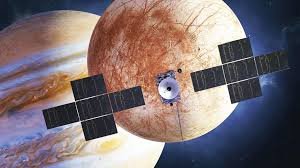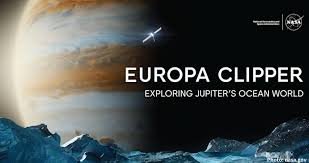Europa Clipper Embarks on Journey to Jupiter’s Icy Moon
Introduction to the Europa Clipper Mission
The Europa Clipper spacecraft, developed by NASA, has officially begun its journey to Europa, one of Jupiter’s most intriguing moons. This ambitious mission aims to explore the icy world beneath Europa’s surface, which is believed to harbor a subsurface ocean capable of supporting life. Launched on October 16, 2024, from the Kennedy Space Center, the spacecraft is expected to reach its destination in approximately 2029.
Scientific Objectives of the Mission
The primary objective of the Europa Clipper mission is to investigate Europa’s ice shell and the ocean beneath it. The spacecraft is equipped with a suite of scientific instruments designed to analyze the moon’s ice-covered surface, measure the thickness of the ice, and study the composition of the ocean. These instruments will enable scientists to assess the moon’s habitability and search for potential biosignatures, which could provide crucial insights into the conditions necessary for life beyond Earth.
Collaboration and Technology
The mission is a collaborative effort involving various NASA centers and universities. The advanced technology incorporated into the Europa Clipper, such as high-resolution cameras and spectrometers, allows for detailed analysis of the moon’s geology and atmosphere. This collaboration not only enhances the scientific output of the mission but also showcases the capabilities of the U.S. aerospace industry in planetary exploration.
Significance of the Findings
The findings from the Europa Clipper mission could significantly advance our understanding of celestial bodies with the potential to support life. Europa’s unique environment presents an unparalleled opportunity for astrobiology, and discovering even microbial life would have profound implications for our understanding of life in the universe. Furthermore, the mission could lay the groundwork for future explorations, including potential landers or orbiters focused on studying the moon more closely.

Why This News Is Important
Advancements in Astrobiology
The launch of the Europa Clipper mission represents a significant advancement in the field of astrobiology. Europa’s ocean is one of the most promising places in our solar system to search for extraterrestrial life. By studying its composition and potential for life, scientists hope to gain a deeper understanding of the conditions that support life in extreme environments.
Expanding Knowledge of the Solar System
The mission will contribute to our broader understanding of the solar system, particularly regarding icy moons and their potential habitability. Insights gained from Europa could inform future exploration of similar celestial bodies, enhancing our knowledge of planetary formation and evolution.
Inspiration for Future Generations
Missions like Europa Clipper inspire future generations of scientists, engineers, and explorers. By pushing the boundaries of space exploration, NASA encourages young minds to pursue careers in STEM (Science, Technology, Engineering, and Mathematics), fostering innovation and creativity in addressing complex challenges.
Historical Context
The exploration of Jupiter and its moons dates back to the early 1970s with NASA’s Pioneer missions, followed by the Voyager missions in the late 1970s that provided the first close-up images of the Jovian system. In 1995, the Galileo spacecraft began an extensive study of Jupiter and its moons, revealing important information about Europa’s surface and suggesting the presence of a subsurface ocean. The scientific community has since recognized Europa as a prime candidate for the search for extraterrestrial life, leading to the development of dedicated missions like the Europa Clipper.
Key Takeaways from “Europa Clipper Embarks on Journey to Jupiter’s Icy Moon”
| Serial No. | Key Takeaway |
|---|---|
| 1 | The Europa Clipper mission was launched on October 16, 2024. |
| 2 | The mission aims to explore Europa’s subsurface ocean, believed to harbor life. |
| 3 | The spacecraft is equipped with advanced scientific instruments for detailed analysis. |
| 4 | Findings from the mission could have profound implications for astrobiology. |
| 5 | The mission inspires future generations to pursue careers in STEM fields. |
Important FAQs for Students from this News
Q1: What is the Europa Clipper mission?
A1: The Europa Clipper mission is a NASA initiative launched on October 16, 2024, aimed at exploring Europa, one of Jupiter’s moons, which is believed to have a subsurface ocean that may support life.
Q2: What are the main scientific objectives of the Europa Clipper mission?
A2: The main objectives include investigating Europa’s ice shell, measuring the thickness of the ice, analyzing the composition of the ocean, and assessing the moon’s habitability for potential life.
Q3: When is the Europa Clipper expected to arrive at Europa?
A3: The Europa Clipper is expected to arrive at Europa in approximately 2029.
Q4: Why is Europa considered a prime candidate for the search for extraterrestrial life?
A4: Europa is considered a prime candidate because it is believed to have a subsurface ocean beneath its icy crust, which could provide the necessary conditions for life to exist.
Q5: What technologies are utilized in the Europa Clipper mission?
A5: The spacecraft is equipped with high-resolution cameras, spectrometers, and other scientific instruments designed to analyze the moon’s surface and potential subsurface ocean.
Some Important Current Affairs Links


















